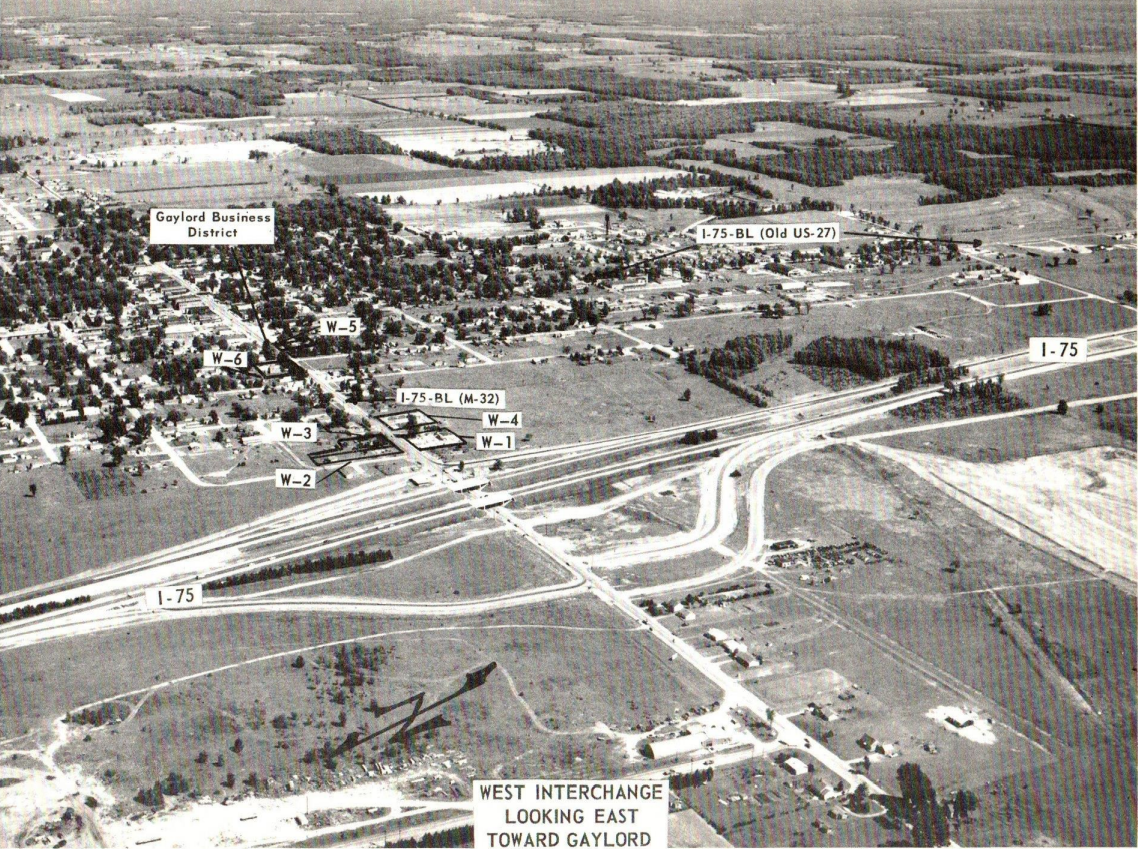I-75 retrospective: One of the most important 20th century events for Gaylord

GAYLORD — Former Mayor Bill Wishart attended the official ceremony that marked the completion of Interstate 75 in Gaylord 60 years ago.
Back in 1958, the Michigan Highway Department unveiled plans to build a new super highway beginning at the state's southern border and ending in Sault Ste. Marie in the Upper Peninsula. Eventually this highway would pass through Otsego County on the western edge of Gaylord.
"It was a bright sunny day and there was a ribbon cutting," Wishart recalled. "Miss Michigan was here and our town was pretty excited about I-75 coming to Gaylord."
It is hard to imagine Gaylord without I-75, yet the town still managed to grow and prosper from its founding in 1873 before becoming a village in 1881 and then achieving city status in 1922.
Wishart and Phil Alexander of the Otsego County Historical Society agree that the arrival of Interstate 75 in 1962 was probably the most significant event to occur in Gaylord and Otsego County in the 20th century, leading to economic and social gains that continue to this day.
"If I-75 didn't happen, what would Gaylord look like," asked Alexander. "I think you would have to look at places like Atlanta for a clue."
Alexander has written a book, "Otsego County after I-75 1962-2022" which has been published by the historical society.

Subscribe: Check out our offers and read the local news that matters to you
Alexander points to the growth Gaylord and the county experienced after the highway was opened. In 1960, the population of Gaylord was 2,568 while the county had 7,545 people. By 1970, those numbers had grown to 3,012 and 10,422, respectively.
In the 1980 census, Gaylord had a population of 3,011 while the county had 14,993.
If anything, the arrival of I-75 made it much easier to reach Gaylord, especially from the heavily populated urban areas downstate.
"It was quite a trip to come to Gaylord from a place like Flint," Wishart said. "It was a five-hour drive and you had to travel on two-lane roads through small towns to work your way up north."
"(I-75) made it much easier to reach Gaylord. There was a lot of stuff going on in metropolitan Detroit and a lot of those families wanted to have a summer home up here or retire and move here," Alexander added.
He believes that I-75 was particularly good for the tourism, real estate and services sectors in the economy. Wishart also noted that shortly after I-75 opened so did a U.S. Plywood plant that would employ hundreds. The plant had been in the works since the late 1950s.
The U.S. Plywood plant originally manufactured particle board under a Swiss patent. U.S. Plywood later merged with Champion International in the1970s and became part of Georgia-Pacific Corp. before the facility was closed in 2006.
"We were enjoying the construction of U.S. Plywood on Dickerson (Road). That meant jobs and people moving here. I-75 was one of the great things that happened to us," said Wishart.
Alexander said the economic growth that the plant and I-75 brought to the area also led to an influx of people, many of whom would become pillars in the community.
More: Gaylord council urges MDOT to present new options for South Otsego project
"You have all of those people moving up here and bringing skills with them," he said. "Gaylord received many transplants who would become important volunteers in the community."
Of course not everyone was happy about the arrival of the highway.
"Everything that came north into town was on U.S. 27 (now called Old 27). Some businesses along U.S. 27 were affected and some of them had to move or had to make it easier for folks to drive into their business," Wishart said.
"There was some fear about the unknown," Alexander added. "If the main highway (U.S. 27) was right in front of your business, you probably wouldn't be thrilled to have all of that traffic move away."
Shortly after I-75 and the U.S. Plywood plant, the city introduced the Alpine motif for the downtown.
"About the same time I-75 opened, downtown Gaylord was looking bad and something had to be done to spruce it up," Alexander said.
The Alpine motif was was introduced to downtown Gaylord by local businessman Gordon Everett.
An early proponent of the Swiss chalet design theme was Harold Elgas, the president of the Gaylord State Bank.
Much like I-75, Elgas played a prominent role as Gaylord and the county began to expand in the 1960s and transition into an economic and social center point for Northern Michigan.
"You could write a book on Harold. He moved here from Cadillac to become president of the bank. That was back when the bank was a big deal and basically the only bank in the county," Alexander said.
"Harold was instrumental in a lot of the things in the community," Wishart added.
Alexander said Elgas and the bank were major factors in businessmen converting their shops to the Alpine theme.
Wishart was employed by Glen's Market at the time I-75 opened. Regarding the owner, C. Glen Catt, Wishart said "He always liked to look ahead."
Shortly before I-75 opened, Catt took an employee on a drive past a big open field located off of what is now Wisconsin Avenue near M-32 or Main Street.
The field was part of a farm. Catt pulled his vehicle into the big field and told the employee he was going to build a grocery store in that spot soon.
Eventually Gordon Everett heard about Catt's plan and told him: "Glen, you have done a lot of really smart things in your life but nobody is going to drive way out in the country to buy groceries," Wishart said.
Catt did build the store and now it is called Family Fare and sits just off the I-75 exit ramp onto eastbound M-32.
This article originally appeared on The Petoskey News-Review: I-75 retrospective: One of the most important 20th century events for Gaylord

